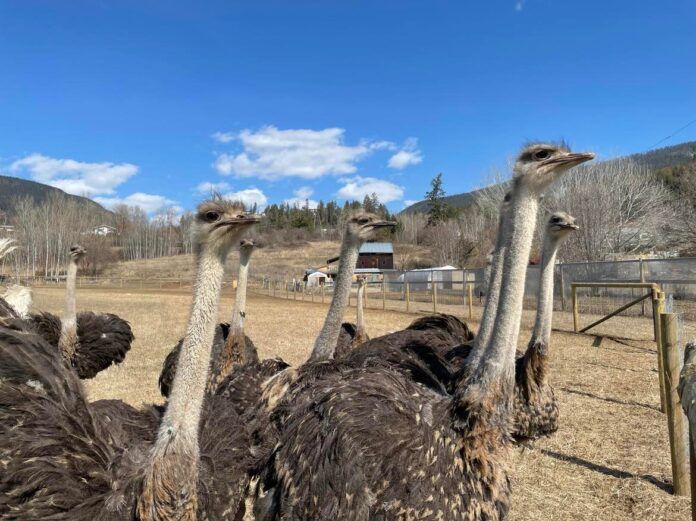There might not be any bush big enough to hide two of these birds.
I was having a bit of a rough week when two of my friends invited me out fishing. Unfortunately, a few hours of no bites did little to improve my mood.
However, a sight on the drive was more than enough to chase my blues away.
At first, I thought I was seeing things. There is nothing that casts quite a similar silhouette, at least nothing that calls Creston home.
I knew of farms that raised them. I just never imagined I’d find one so close to home.
Ostriches!
Giant, towering birds, more similar to a dinosaur than to a chicken, dotted a nearby field as my friend drove by.
I yelped in delight, surely startling both of my buddies out of their own fishing depressions.
What was a usual sight to those well-versed in the area was, in fact, an absolute pleasure for me.!
And one I was determined in sharing with my wife.
The next day, I found myself driving back to the farm, this time, with my lovely wife in tow.
We carefully picked a spot off the road, parked our vehicle, grabbed our birding binoculars, and approached the fence.
Now, I offer a word of advice: Don’t do this. The only reason I did was to perhaps meet the farmer of the ferocious-looking, feathered, and friendly fellows.
Luckily for me, I did.
Sue Foraie first got into farming ostriches in the 1990s.
“It was actually a friend that told me about ostriches and about people raising them, sort of as a joke I guess,” chuckled Foraie.
“But, I took it a little more seriously than that.”
However, it wasn’t an easy road. She had to step out of the business around 20 years ago when the meat market didn’t pick up to match the breeding one.
“Everyone was blinded by huge amounts of money they were making at the time from selling their stock. So that market just sort of petered out.”
After purchasing a fine piece of land outside of Creston, she thought she would give it another chance.
“I’ve always had the ostrich in my mind. They are such a nice, easy animal to take care of. They’re very personable, not hard on fencing, and don’t require a lot of land to live on, although they do like to exercise and run.”
And that they do.! As my wife and I watched, they pranced and danced, coming right up to the fence to stare at us with glassy, yet curious, eyes.
Foraie says ostriches are very unique animals to raise, as you might believe. Unlike cattle or pigs, they can produce offspring at an astonishing rate.
“You can potentially have 50 of them be ready for market in just over a year, as long as they’re fed well and taken care of.”
In fact, they produce similarly to chickens, as both are birds. However, besides the obvious size difference, there is another major difference between the two.
“It is a red meat, like beef. Very low in cholesterol and fats, while high in particular vitamins. A very healthy meat.”
Foraie says it is a meat that heart specialists suggest for those who need to be on a strict low-cholesterol diet.
However, that doesn’t mean ostrich is for everyone. Foraie says some can’t get past its dinosaur-like appearance.
“A lot of people find it very weird looking at an ostrich walking around out there because they aren’t used to seeing an animal that looks like that in the first place.”
Despite a passion for food that my waistline hates, I find myself slightly uneasy with the prospect at times.
That doesn’t take the wind out of her sails though.
“I love raising ostrich. I think they are the meat of the future. I have lists of people who want to purchase product when I have it available. And they are just such easy keepers.”
That being said, if you have a hankering for some ostrich, you’ll have to wait for now. Foraie isn’t quite ready to head to market.
When I think of ostriches, I picture deserts and lions. Certainly not the somewhat chilly atmosphere of Creston in March. However, Foraie says they do quite well in our climate.
“I raised them in Alberta as well, where we can have minus 40, minus 45 weather. And those guys do seek shelter in the wintertime. They will go in and stay there. I have never seen any get frostbite.”
And a Creston summer is no sweat off an ostrich’s feathers.
“They can actually internally cool their body temperature so they don’t overheat like other large animals do. Most times when it’s very hot out there, you will see them just sit down.”
There is a slight concern Foraie has for raising ostriches, one I actually found myself contributing to.
The road the farm is located on is a busy one. And the spot where the farm is drops from an 80 km/h zone to a 50km/h zone. So, onlookers lured in by the Jurrasic Parkesque- view could find themselves at risk of a collision.
“I worry about that, especially on the weekends. We do still have the heavy truck traffic coming from the mill and they’re sometimes coming through at a pretty good clip.”
So, despite the allure of a big bird in a birding town, Foraie urges everyone to drive through safely and stop only if you need to.
“We can’t be touring people every time somebody wants to pull in and have a look at the birds,” explained Foraie.
“If you’re coming through, try to find a spot somewhere to pull in and out of the way to not be in the way of those trucks that come by. It’s just nightmarish for me to think about that.”


